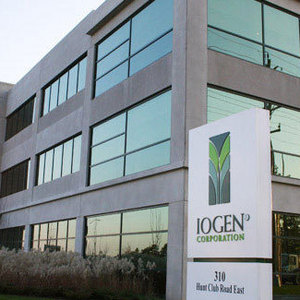Iogen announces new drop-in cellulosic biofuel from biogas

Iogen Corp.
January 23, 2014
BY Susanne Retka Schill
Ottawa-based Iogen Corp. announced it has developed and patented a new method to make drop-in cellulosic biofuels from biogas using existing refinery assets and production operations.
“Biogas is produced today from landfills, wastewater treatment plants, waste digestion facilities and farm digesters with well-proven technology,” said Patrick Foody, Iogen’s executive vice president, advanced biofuels. “We can now take biogas and make specification gasoline and diesel with renewable content using well-proven existing refining operations. It is a win for everybody.” Foody announced the new biofuel strategy at the U.S. EPA’s Landfill Methane Outreach Project Conference, Jan. 22 in Baltimore. The company estimates there is refining capacity in place to incorporate 5 to 6 billion gallons per year of renewable hydrogen content into gasoline and diesel fuel.
Foody explained to Ethanol Producer Magazine that the new approach would require no capital expenditures for those biogas producers already cleaning biogas to pipeline specifications, nor would it require capital expenditures for refineries already using natural gas. Essentially, the biogas with its renewable hydrogen content (RHC) receives RINs credits (the renewable identification numbers used for compliance with the renewable fuels standard, RFS) as it enters the pipeline, which are then sold under contract to a refiner already using natural gas to make hydrogen in steam methane reformers for use in hydrogenation in oil refining. EPA already has criteria in place for how to validate such contract flows, as opposed to an actual physical flow of molecules. Foody added that the company learned in December that its patents were approved for the use of renewable hydrogen in refineries to make renewable content and fuel credits.
Advertisement
Advertisement
The company is in negotiations with several California landfills and oil refineries to employ the approach, but first, the EPA must approve the pathway, Foody said, “and I can’t forecast that.”
Several pieces of the regulatory puzzle are in place, however. The EPA currently recognizes biogas used in transportation for the generation of advanced biofuel (D5) RINS and has proposed that biogas converted into certain transportation fuels can earn D3 RINS (for cellulosic biofuels). Iogen is also seeking regulatory approval for RHC under California’s Low Carbon Fuel Standard. Foody added that receiving RINs credits for biogas production would be a higher-value use. The company is projecting premiums to natural gas should range between $12 to $17 per MMBtu.
Advertisement
Advertisement
Iogen developed the biogas-to-cellulosic fuels approach as it examined sending the tail end of fermentations to an anaerobic digester as a way to increase the efficiency of its cellulosic ethanol process. The technology would increase the overall cellulosic biofuel yield per unit of feedstock, lower unit capital costs and lower water usage per unit of biofuel production.
The company is planning to use the biogas technology in association with two large-scale cellulosic ethanol projects under development in the U.S. “We’re looking at wheat straw and corn stover as feedstocks for projects in Kansas and North Dakota,” Foody said. “This approach ups the total yield of cellulosic biofuel,” he said. “We not only get RINs out of ethanol but we get them out of the biogas, too.”
Iogen Corp. has operated a demonstration-scale cellulosic ethanol plant in Ottawa for nearly 10 years. Its first commercial-scale plant is under construction in Brazil and is expected to begin operations later this year. The $100 million project is a joint venture between Iogen Energy and Raízen Energia Participacoes S/A. The 10 MMgy plant is being built adjacent to Raizen’s Costa Pinto sugar cane mill in Sao Paulo. Raizen, Brazil’s leading manufacturer of sugarcane ethanol, is a $12 billion joint venture between Royal Dutch Shell and Brazilian ethanol company Cosan S.A.
Related Stories
The USDA significantly increased its estimate for 2025-’26 soybean oil use in biofuel production in its latest World Agricultural Supply and Demand Estimates report, released July 11. The outlook for soybean production was revised down.
The U.S. Energy Information Administration maintained its forecast for 2025 and 2026 biodiesel, renewable diesel and sustainable aviation fuel (SAF) production in its latest Short-Term Energy Outlook, released July 8.
XCF Global Inc. on July 10 shared its strategic plan to invest close to $1 billion in developing a network of SAF production facilities, expanding its U.S. footprint, and advancing its international growth strategy.
U.S. fuel ethanol capacity fell slightly in April, while biodiesel and renewable diesel capacity held steady, according to data released by the U.S. EIA on June 30. Feedstock consumption was down when compared to the previous month.
XCF Global Inc. on July 8 provided a production update on its flagship New Rise Reno facility, underscoring that the plant has successfully produced SAF, renewable diesel, and renewable naphtha during its initial ramp-up.
Upcoming Events










